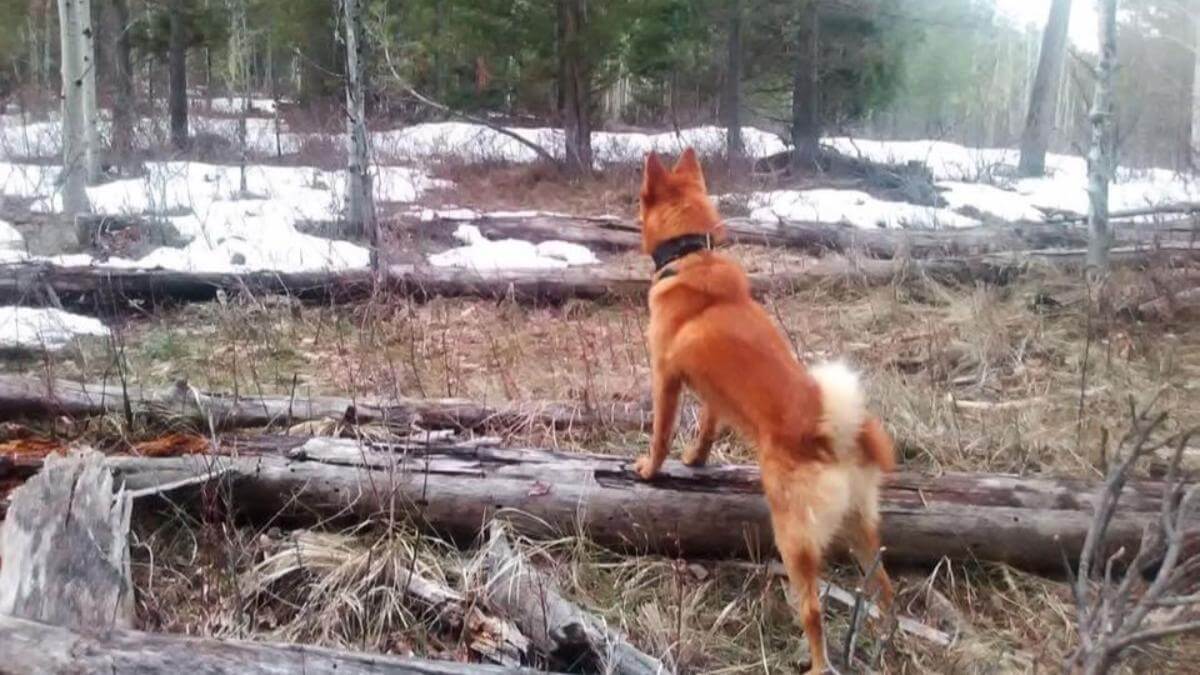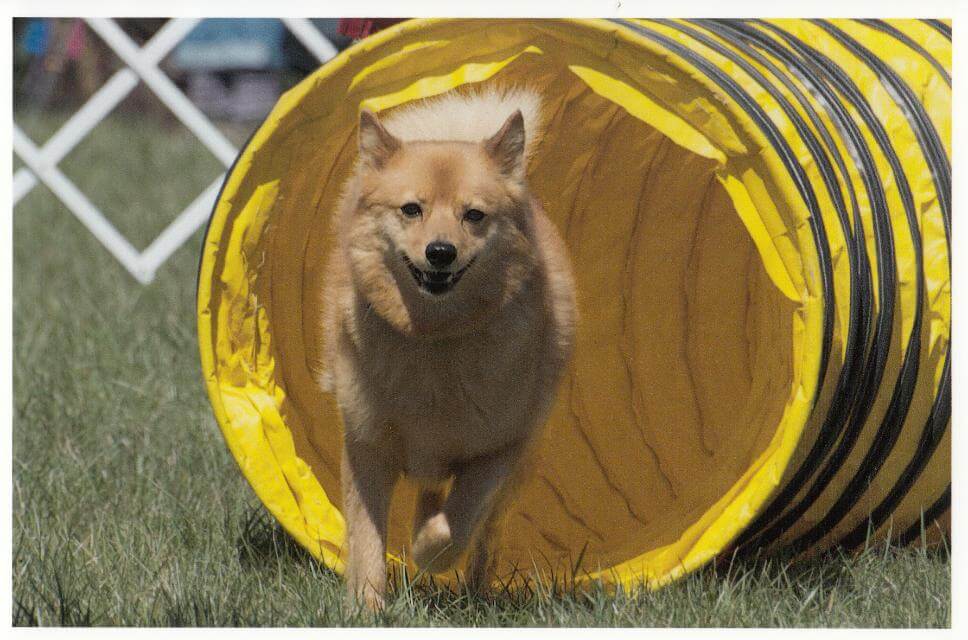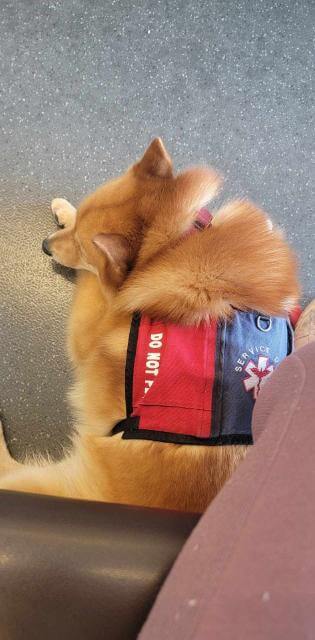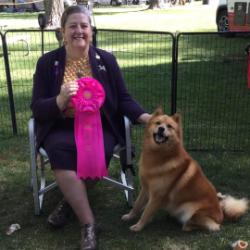


Home » The Versatile Finnish Spitz

The Finnish Spitz is the national dog of Finland, considered a national treasure. They have a long, illustrious history in the country as a versatile and reliable hunting companion. Primarily used on a grouse-like bird called the capercaillie, they can and will hunt everything from large game down to squirrels (much to the chagrin of all hunters), and will even go to ground. Their variegated red coats, which one would expect to stand out in a forest, in fact blend in perfectly with the underbrush, fallen timber, and shadow on the forest floor. The only obvious thing is their glorious gold tail, bobbing along and catching the filtered sunlight to work as a tracking beacon. That, along with their famous (or infamous, depending on your location) ringing bark that is supposed to be able to be heard from miles away in thick forest, are hallmarks of the breed. Hunting is done with one dog and one hunter as a team, with the dog searching for the desired prey and either reporting back to the hunter for further direction or flushing and treeing, or cornering, it and barking to alert the hunter to its success. That bark then becomes the homing beacon for the hunter to follow, also covering the sound of the hunter’s approach.
But here in the US, the type of hunting they do is generally not allowed. Hunters here must shoot birds on the wing, not roosting. And there are few animals that are allowed to be hunted by hunters with dogs. So, what are those of us breed aficionados to do if we insist on keeping the breed true to its foundation?

Keeping in mind that I am not familiar with ALL hunting rules across the country, I can share a few experiences that I have had or have had shared with me. Also, I am not a hunter. However, I love being in the wilderness and grew up hiking and camping in the Rocky Mountains and Uinta Mountains. I inquired with the Forest Service about “hunting” with my dogs, and was told that as long as the only thing I’m shooting with is a camera, and as long as I follow the rules regarding not harassing wildlife or unduly stressing them during mating or nesting seasons, then their hunting style is perfectly acceptable. Since they distract or “entertain” the prey to keep it from fleeing, no physical harm is done to any of the animals they are able to successfully track and flush.
My first breed was Alaskan Malamutes, so adding them to a backpacking trip was a natural thing to do. Although my Finnish Spitz can in no way carry the weight that a Malamute could, they helped me reacquaint myself with the forest. Malamutes focus on the trail. “Follow the Trail” is their motto and mantra, pulling the human or sled or whatever right along with them. Unless wildlife practically tramples them, they have little interest in it when they are working, and it’s easy to fall under that spell. But the Finkies are aware of, and are alert to, every little thing around them: the breeze in the trees, the rustle of wings, skittering in the underbrush, a flash of light or color near a stream. Wow! Did you notice that there’s a forest on either side of that trail?! Hiking with a Finnish Spitz is a unique opportunity to rediscover the forest or hills or meadows or wherever you take your adventures.
I also take advantage of walks at rest areas, parks, or trails with flexi-leads to let my dogs find what they may. Even just in my neighborhood there are plenty of things to catch their attention, though it may just be a cat. They have scared up mice, squirrels, and birds, and in the high desert areas of the West there are a few places with prairie dog towns that give them ample chances to practice going to ground. We call it “whack-a-mole,” as the prairie dogs pop up in one hole and bark so that the dogs run for them, then drop and pop up in another hole several yards away. The repeated process will entertain them for as long as you have!
One of the homes I was blessed to find for one of my older puppies was specifically looking for a Finnish Spitz for hunting. The man’s grandfather was from Finland and he had grown up with, first, a few experiences with an old dog and then stories of hunting with him and others. The dog I had was a born huntress, to the extent that I had to keep her away from any place where there might be something to hunt until she’d pottied when we stopped or she simply would not do it. Within her first few days of living in her new home, she found and caught a rockchuck; within a year she was providing a good showing at the family coon hunt. In following years, she “won” the family coon hunt and was helping the lion hounds. She provided that all-important distraction while the hounds got into position to cut off the escape route. Her skills helped put food on the table, in addition to being a beloved member of the family.
Obedience with any Arctic breed can often feel like an endless exercise in futility. There is a reason why few of them compete in any of the companion event rings: traditionally, one would get more success and satisfaction beating down a brick wall with one’s head (and that would also be far less embarrassing than the creative disobedience at which Arctic dogs excel). Finnish Spitz can break that tradition.
I know this sounds difficult to believe. I was skeptical myself when my friend dragged me to my first competition Obedience class. I had always insisted that my dogs know basic obedience, but I knew that it was a far cry from the precision moves required for a CD and beyond. But at one point in my life, I found myself in a unique situation: owning only one dog. Kodi had finished his championship more quickly than expected and wasn’t ready to be a Special, so it was either stop showing, which I love too much to consider, or try something new.
Finnish Spitz are highly intelligent, so they learn quickly when they enjoy what they’re doing. And that’s the catch. Training for competition is repetitive, which is boring. Finnish Spitz want to please their humans, but they will not do endless repetitions just to prove it. I decided that doing Obedience with a Finnish Spitz isn’t so much “training” as it is “teaching.” We must keep in mind that these dogs were bred to track and tree prey, independent of the hunter, so they had to be able to make decisions without being commanded to first. They had to think, and they still want to think—not simply take orders.

By varying teaching styles and working Obedience moves into games, Kodi and I learned together what we needed to do. After a year of training, we entered our first show. True to Arctic dog personality, Kodi couldn’t resist doing creative interpretations of some of the exercises—like heeling on my right instead of my left, and skipping the sit on the recall to go right around me and finish. Kodi thought it was funny (no one could miss his big happy grin); I was mortified—until I caught the judge trying to hide his laughter behind his clipboard. Our score was nowhere near the sparkling 190s and 200s of the “traditional” Obedience breeds, but we qualified—and had fun while doing it.
Once we earned our CD, we were back to needing something to do. So, we tried Rally—and truly found our niche. It is fun and challenging—and not quite as embarrassing. Precision is still needed to get high scores on the exercises, but the course and exercises are different every time, so Kodi doesn’t feel the need to be creative with them to keep himself (or the judges) entertained. Or at least not as often.
Over our years of competition, Kodi swung from one extreme to the other. At an Obedience Veteran Special Attraction, he won High in Trial! However, a few months later I felt the need to apologize to the judge, as in Rally Excellent he practically dug a trench with his nose in the asphalt ring (in a building also used for livestock shows for the fair).
Despite the rollercoaster of emotions and performances, it truly is a lot of fun, and provides a way to bond with your dog on a totally new level as you learn to work together as a team. And you may discover, as Kodi and I have, that sometimes it’s fun to be comic relief for the staunch Obedience competitors!
The square build of the Finnish Spitz is ideal for springing over or onto fallen trees, rocks, or other obstacles encountered in the wild. Therefore, it translates well into the Agility ring. Their instinctive ability to work off-lead is an advantage, as they don’t feel the need to be glued to your side at all times. As independent, intelligent dogs, they want to be challenged. But they also want to have fun! Agility is the perfect opportunity to do all of those things. The challenge is to keep it fun, not over-training obstacles that might be difficult or perhaps not as fun as some of the others. Choosing a trainer who understands this is important going into it.
The potential detriment of the breed’s square build is that Finkies aren’t going to be as fast as the dogs in their height category, usually the Border Collies or Shelties. But speed isn’t everything! I’m not as fast or nimble as I used to be, so the speed of a Finnish Spitz is just about right. We can work together while not having to stress about being too far apart, and the risk of a missed jump because the dog outpaces the handler is much reduced.
For those wondering if moving from the more predictable Obedience ring to the excitement found in Agility affects the comic relief aspect: sorry, no. At our first trial, RockZ stopped dead in front of one of the last jumps, her chest nearly touching the bar, and barked at me. I stopped and said, “What?! Come on! We’re almost done!” She gave me her “stupid human” look, then sprang over the bar and finished the course, clear but over time. The trial was being recorded, and our run seemed to run on an eternal loop all weekend!

One of the most fascinating aspects of the Finnish Spitz is their sensitivity. While hunting, it gives them an edge over their prey and also over some other breeds of hunting dogs that are more specialized. In the Conformation ring it can often be a liability, as they can be easily overwhelmed in a noisy or very busy environment like a big indoor show. But an unexpected surprise of this sensitivity is their ability to read the people around them in their homes. I have had the pleasure of knowing three dogs who have taught themselves to be service dogs or emotional support dogs, and one Certified Service Dog and one more in training to become one. Two of these dogs were sold simply as pets, but to families who had children on the autism spectrum. With no official training or intent on the part of their owners, these dogs learned not only the best way to act around those children, but also how to support them. The third one who taught himself had an owner who was blind in one eye; he instinctively placed himself on that side of his owner in public to create a barrier, not only to keep anyone from getting too close, but also to guide his human away from a potentially unseen obstacle.
As a general rule, Arctic dogs aren’t known to excel in the realm of service dogs. Once again, more trainable and tractable breeds are usually chosen first. But my experience shows that this is a breed that should not be automatically dismissed simply because they tend to have an otherwise independent spirit. Although I have not competed in the sports of Barn Hunt, Scent Work, Tracking, or Fast CAT, I know others who have and have done extremely well!
My more than two decades of experience with this remarkable breed has taught me to never count these versatile red dogs out. If you want to try something, odds are that the Finnish Spitz will be more than willing to try it along with you. Just remember to have FUN! Because that has been the number one goal of every Finkie I have ever owned, closely followed by the desire to be with their human teammate.
